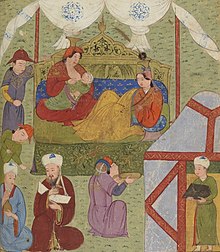This article needs additional citations for verification. (January 2019) |

The history and culture of breastfeeding traces changing social, medical and legal attitudes to breastfeeding, the act of feeding a child breast milk directly from breast to mouth. Breastfeeding may be performed by the infant's mother or by a surrogate, typically called a wet nurse.

In most societies, women nurse their own babies. In the case of death, illness or situation a mother cannot suckle her own baby. Before the availability of infant formula, in those situations, unless a wet nurse was found promptly, the baby might die, and infant mortality rates were high. Wet nurses were a normal part of the social order, though social attitudes to wet nursing varied, as well as to the social status of the wet nurse. Breastfeeding itself began to be seen as common; too common to be done by royalty, even in ancient societies, and wet nurses were employed to breastfeed the children of royal families. This attitude extended over time, particularly in Western Europe, where babies of noble women were often nursed by wet nurses. Lower-class women breastfed their infants and used a wet nurse only if they were unable to feed their own infant.[1]
Attempts were made in 15th-century Europe to use cow or goat milk, but these attempts were not successful. In the 18th century, flour or cereal mixed with broth were introduced as substitutes for breastfeeding, but this was also unsuccessful. Improved infant formulas appeared in the mid-19th century, providing an alternative to wet nursing, and even breastfeeding itself.[1]
During the early 20th century, breastfeeding started to be viewed negatively, especially in Canada and the United States, where it was regarded as a low-class and uncultured practice.[2] The use of infant formulas increased, which accelerated after World War II. From the 1960s onwards, breastfeeding experienced a revival which continued into the 2000s, though negative attitudes towards breastfeeding were still entrenched up to the 1990s.[2]
- ^ a b Stevens, Emily E.; Patrick, Thelma E.; Pickler, Rita (2009). "A History of Infant Feeding". Journal of Perinatal Education. 18 (2): 32–9. doi:10.1624/105812409X426314. PMC 2684040. PMID 20190854.
- ^ a b Nathoo, Tasnim; Ostry, Aleck (2009). The One Best Way?: Breastfeeding History, Politics, and Policy in Canada. Wilfrid Laurier Univ. Press. ISBN 978-1-55458-171-9.[page needed]
